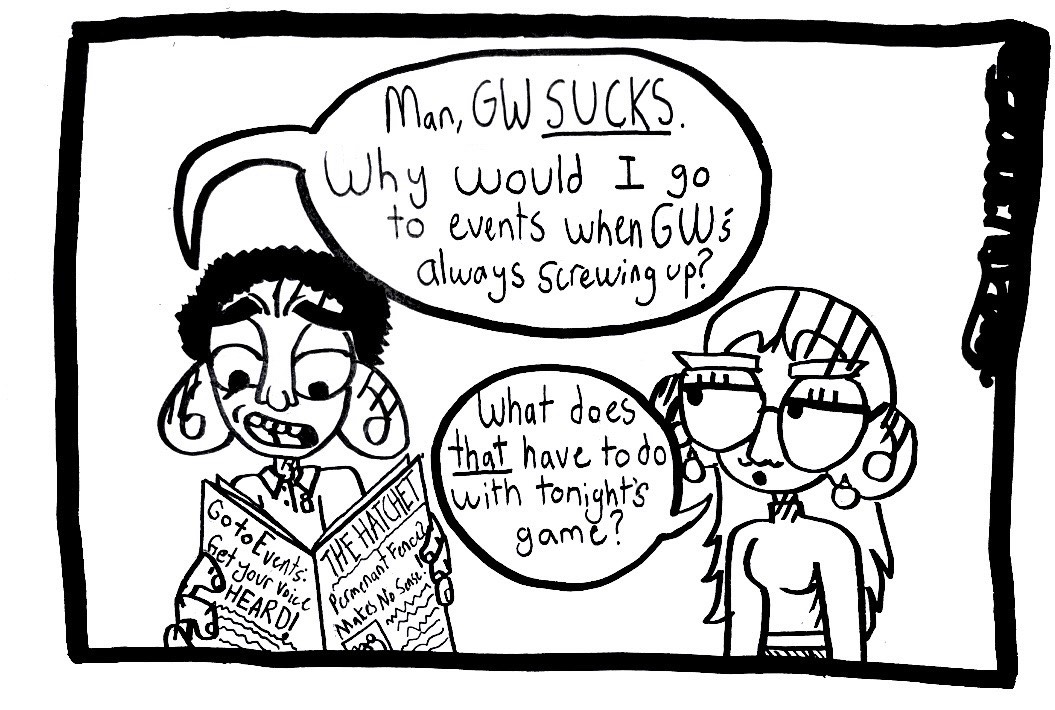When I was debating whether or not to come to GW, my online research revealed a lot of the same criticism. The University has no community. Many online forums – where current students and alumni discuss the pros and cons of their schools – feature students at GW talking about how there is no one place for students to interact.
Once I got to GW, I realized that these criticisms were accurate. The design of some residence hall lounges in the basements of buildings, like Thurston and Fulbright halls, contributes to the lack of community feeling. Within the residence halls – which is where students spend a large portion of their time on campus – students don’t have inviting areas to meet new people in a casual setting. Conversely, at other schools similar to GW, like Georgetown and Boston universities, traditional freshman and upperclassman residence halls have a lounge on almost every floor where students live, instead of just one in the basement. In order to create spaces where students will want to hang out, lounges in older buildings like Thurston and Fulbright should exist on the main residential floors. Although this would be a large investment for GW, it would pay off to create a better community for students and could even lead to improved retention. But if these large-scale renovations are not attainable in the immediate future, then spaces must be made to feel more inviting and casual, with comfier furniture and clear separation of space that is designated for studying or just hanging out.
When I was living in Thurston last year, I quickly noticed that the basement lounge space was confusing in design. The space contains a kitchen, a study room and a “hangout” area with giant bean bags all in one place – leading students to not know which areas they’re allowed to talk in without being disrespectful to the people studying. This design led my roommates and I to opt to stay in our room unless we wanted to cook. This contrasts from the lounges I saw my friends use in Potomac House and at other universities, which were located on some of the floors where students live in, in addition to the basement. This allowed my friends at other schools to easily befriend the residents hanging out in the lounges, leading to a “community” feeling within their living space. In Thurston, I mostly saw people travel down to the basement to cook a meal and leave, or study for a test. The space itself was not conducive to creating a community.
But this is not a new complaint. The Student Association has advocated efforts to improve community here, like the new “living room” style area in the Marvin Center. This addition is a step in the right direction, but it would make more sense to also create this casual atmosphere in a living setting, rather than a multi-purpose building like Marvin. While Thurston is an older building, students have successfully made the case for renovations before, resulting in improvements like the communal kitchen built in 2014 after negotiations between the University, the Residence Hall Association and other student leaders. A communal and welcoming lounge space in residence halls is one of the best ways for students to connect. Making friends in classes can sometimes lead to transactional relationships, while friendships made through student organizations can create an effect where the relationship lies in only one common interest. Meeting new people in a setting with no underlying agenda or specific purpose can be a great way for students to genuinely connect.
Now I live in Fulbright, which has the same problem as Thurston. A few weeks ago, I received an email that the Fulbright lounge renovations – which include new carpets, a newly built kitchenette, an entertainment system, a new linoleum floor and furniture – will be completed after winter break. If those same costs were similarly applied to moving the lounges into a better location, they would be a more worthy investment. The costs of breaking down walls may be pricier, but it would transform the lounge into a more frequently used space, making it more worthwhile than trying to fix a space that isn’t used.
But if major renovations like this aren’t possible in the near future, better organization of the space could help improve these basement lounges in the meantime. Officials could start with a reorganization of couches and study tables to establish clearly which space is intended for each purpose.
Both Fulbright and Thurston are older buildings that are cheaper to live in than other residence halls on campus, so it’s understandable that the newer buildings – like Potomac and District House – have updated features. But giving students who can afford more expensive housing the opportunity to naturally meet people on their floors in a common space isn’t fair to those who can’t afford more expensive housing or elect for cheaper options.
The renovations to create a better residential lounge in a prime location could be costly, but these residential halls are older, and the walls and floors are already constantly facing renovation costs. There have even been recent discussions of proposals for Thurston renovations. Since these buildings undergo renovations frequently, larger scale renovations that would benefit student community-building shouldn’t be out of the question.
On a campus that is already heavily criticized for a lack of community culture, having spaces to build community is essential. With lounges in more central locations, students can have a chance to build their communities in their homes away from home.
Rachel Armany, a sophomore majoring in journalism, is a Hatchet columnist.
Want to respond to this piece? Submit a letter to the editor.


